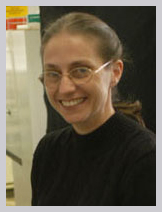Rossitza Alargova
| PhD, Physical Chemistry, 1999 Sofia University, Sofia, Bulgaria Curriculum Vitae Publications |  |
Research Focus: Synthesis and Self-assembly of Particles with Anisotropic Shape, and/or Dipolar Charge
Synthesis and self-assembly of particles with anisotropic shape, and dipolar charge.Synthesis of nano- and microparticles with directional ordering interactions, able to self-assemble in a predefined way, may introduce a qualitatively new level of complexity and precision in the fabrication of micro- and nanostructures and hence in the production of new materials for the electronic and computer industry. One way to control interparticle interactions in order to induce formation of a given structure is to use particles with anisotropic shape, and/or dipolar charge. For instance rod-like particles predominantly arrange themselves longitudinally forming liquid crystalline (nematic or smectic) phases at relatively low concentrations. However, such phenomena have been little studied, since cylindrically shaped particles are not easily available.The aim of the above project is to synthesize polymer nano- and microparticles with anisotropic shape or charge distribution and to study the possibilities for their organization into structures possessing interesting photonic, optical or electrical properties.
So far we have developed a method (proprietary) for fabrication of large amounts polymer microrods in a suspension (Figure 1A). The synthesized particles have regular cylindrical shape and large aspect ratio as is seen from pictures B and C taken with higher magnification. They can be used directly as obtained, transferred to another medium, concentrated or dried. The procedure is flexible and allows control over the particle characteristic sizes, aspect ratio, charge, and content.

Figure 1: Micrographs of polymer microrods.
At present we are studying various operational parameters of the process to improve the synthesis and to be able to fabricate polymer rods with desirable sizes and low polydispersity. Our plans for future work include producing dipolar polymer rods or spheres, and studying the organization of the newly synthesized particles in nano- and microstructures.
Publications
